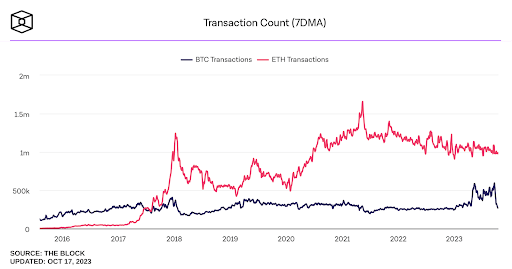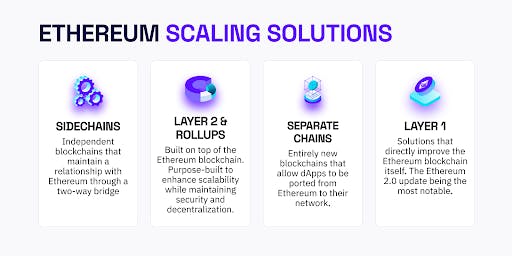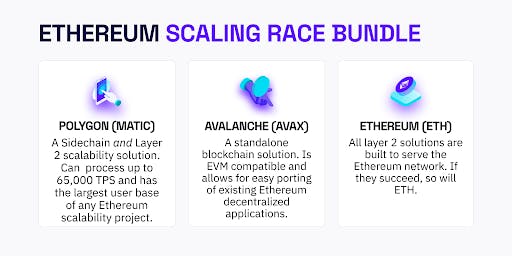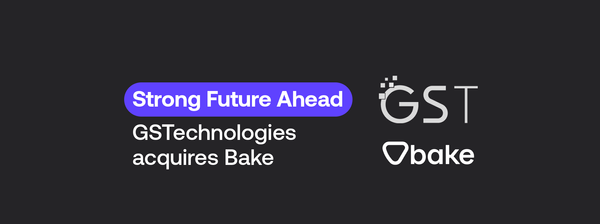Ethereum's Scaling Race: Smart Bundle Deep Dive
Ethereum is a powerhouse in the crypto space, breaking ground as the first blockchain to use smart contracts and allow the deployment of decentralized applications (dApps).
Ethereum’s native token, ether (ETH), claimed the spot of the second largest cryptocurrency by market cap soon after its release. To date, it is the only cryptocurrency to have ever legitimately challenged bitcoin for the number one spot.
However, the network quickly became a victim of its own success. The increase in users and developers on the network led to the blockchain facing significant congestion issues.
This first arose during the infamous CryptoKitties craze of 2017, when transaction fees (gas fees) rose to above $10 for the first time. In 2022, during the height of the DeFi and NFT craze, these issues came to a head when gas fees rose to almost $200.
This prompted the crypto community to propose solutions to Ethereum’s congestion issues. Projects were launched, and developers began rolling out novel solutions to improve the network’s scalability and solve the issues burdening the industry's biggest decentralized ecosystem.
This article will explore the different scalability solutions currently available and guide you on how to use Bake’s “Ethereum's Scaling Race” Smart Bundle to invest in projects building such solutions.
Understanding Ethereum's Congestion Issue
You can visualize Ethereum’s congestion issue as passengers waiting to board a train. Every transaction is a person waiting to board, and each train carriage is a “block” in the blockchain.
Each block (carriage) can only fit so many transactions (people), so the more transactions submitted to the network, the longer it takes them to find a place in a block.

Visualization of network congestion: txstreet
Three main factors cause Ethereum’s network congestion issues:
1. Increased Demand
The most apparent cause of this congestion comes from increased network demand. As more users submit transactions, the number of unconfirmed transactions awaiting confirmation balloons.
Layer 2 solutions aim to alleviate this demand by taking the bulk of the transactions off-chain (more on layer 2 solutions below)
2. Small Block Size
The second issue that causes congestion is the size of the blocks (carriages). Ethereum has a defined block size, restricting the maximum number of transactions that can be included in a single block.
This limitation becomes a bottleneck when transaction requests outpace the block's capacity to accommodate them. Furthermore, transactions are not ordered by time, but by fees. By paying a larger gas fee, you can skip to the front of the queue. This causes transactions with lower fees to get stuck for multiple hours or even days during periods of high network congestion.
3. Slow Block Times
The other issue Ethereum faces is the time taken to add a new block to the blockchain (block time). A new block is added to the Ethereum network approximately every 13-15 seconds.
This is significantly faster than Bitcoin's 10-minute block time. However, it is still not enough to keep up with the flood of transactions during times of heightened activity.

Ethereum’s daily transaction count overtook Bitcoin in 2017: The Block
Ethereum Scaling Solutions
Several solutions have emerged to address Ethereum’s congestion issues. These solutions aim to lower transaction wait times, reduce transaction fees, and improve the overall user experience.

Here's a breakdown of the various solutions developed to solve Ethereum’s scalability problem:
Sidechain Solutions
Sidechains run in parallel to the main Ethereum blockchain. They maintain a relationship with the Ethereum network through a two-way bridge, which allows all assets on the Ethereum network (e.g., tokens, NFTs, etc) to be transferred freely back and forth between the chains.
Sidechains operate as independent blockchains with their own consensus mechanisms. This independence is what allows them to have faster transaction times and lower fees compared to the Ethereum mainnet.
However, this comes at a cost. Sidechains do not inherit Ethereum's security properties and may sacrifice some measure of decentralization or trustlessness for scalability. Each sidechain is responsible for its own security, which can potentially expose it to a higher risk of malicious activities.
But this issue is solvable by implementing certain Layer 2 solutions into the sidechain’s consensus mechanism. This is how Polygon (MATIC), the highest-profile Ethereum sidechain, operates.
Layer 2 & Rollup Solutions
Layer 2 solutions are built on top of the existing Ethereum blockchain (Layer 1). Unlike sidechains, they are purpose-built to enhance the network's scalability without compromising security or decentralization.
They work by processing multiple transactions away from the main Ethereum blockchain (off-chain). These transactions then combine into a single transaction (in one form or another), which is verified by the main blockchain.
Simply put, Layer 2 solutions take the strain away from the main blockchain. Instead of processing multiple transactions individually, Ethereum only needs to process one.
One of the most promising Layer 2 solutions is rollups. Vitalik Buterin, Ethereum's co-founder, has emphasized the importance of rollups in the Ethereum roadmap, suggesting they are central to the future scalability of the network.
Optimistic Rollups and zk-Rollups are the two primary types of rollups, with projects like Optimism (OP) and Arbitrum (ARB) leading the way.
Layer 1 Solutions
Layer 1 solutions aim at directly improving the Ethereum blockchain itself. The most notable Layer 1 solution is the Ethereum 2.0 update, which includes the introduction of a Proof of Stake (PoS) consensus mechanism through the Beacon Chain and sharding.
The Beacon Chain is already operational, and it is what allowed Ethereum to transition from a Proof of Work (PoW) to a Proof of Stake (PoS) consensus mechanism. This has already led to faster transaction validation and reduced block times.
Sharding, the next innovation to be introduced by Ethereum 2.0, involves splitting the blockchain into multiple smaller chains called ‘shards.” Each shard is capable of processing transactions independently, significantly enhancing the network's scalability and reducing the load on any single chain (or “shard”).
Ethereum Scaling Race Bundle
To optimize your exposure to Ethereum scaling solutions, you can use Bake’s “Ethereum Scaling Race” Smart Bundle.
It is designed to provide you with a balanced portfolio of the different types of Ethereum scaling solutions.

The Ethereum Scaling Race bundle includes:
Arbitrum (ARB)
Arbitrum is a Layer 2 solution that allows for near-instant transactions at a fraction of the cost found on the Ethereum mainnet through the use of Optimistic Rollup (OR) technology.
ORs operate under the assumption that all transactions are valid by default, which allows for faster processing times. However, they also include a mechanism for challenging transactions suspected of being invalid. This challenge mechanism allows it to maintain integrity while still allowing for scalability.
Arbitrum's architecture is designed to be fully compatible with Ethereum. Developers can deploy their Ethereum dApps on Arbitrum without any modifications.
Arbitrum’s native token, ARB, makes up 40% of the Ethereum Scaling Race Smart Bundle.
Optimism (OP)
Optimism takes a similar approach to scaling with its Optimistic Rollup solution. Unlike Arbitrum, it sets itself apart with a strong focus on simplicity and community.
Optimism's infrastructure is designed to be a straightforward extension of Ethereum. It maintains the Ethereum Virtual Machine's (EVM) capabilities, enabling developers to deploy smart contracts with minimal changes.
Beyond its technological capabilities, Optimism is also committed to funding public goods through a portion of transaction fees. This retroactive public goods funding model is a pioneering approach in the blockchain space, reinforcing the Ethereum ecosystem’s decentralized values.
Optimism’s native token, OP, makes up 30% of the Ethereum Scaling Race Smart Bundle.
Polygon (MATIC)
Polygon is a Sidechain and Layer 2 scalability solution for Ethereum. It operates alongside Ethereum and uses a two-way bridge to allow assets to move back and forth between the two networks (like a sidechain).
However, it also uses its own Layer 2 solutions within its consensus mechanism to leverage the security and decentralization of the Ethereum network directly.
Polygon can currently process up to 65,000 transactions per second and has the most robust ecosystem and established user base of any Ethereum scalability project.
Polygon's native token, MATIC, makes up 30% of the Ethereum Scaling Race Smart Bundle.
The Path Ahead
The race to scale Ethereum is a testament to the remarkable ecosystem and decentralized community the network has grown. As solutions like Polygon, Arbitrum, and Optimism continue to mature, we will begin to see new, powerful dApps and DeFi protocols emerge, bringing us closer to a decentralized financial future.
The Ethereum Scaling Race bundle is one of multiple optimized investment bundles now available on Bake.
DISCLAIMER: Please note that the information on this blog and in any articles posted on this blog is for general information only and should not be relied upon as financial advice. Cake Pte. Ltd., Bake, UAB, and its affiliates (the “Cake Group”) are not licensed financial advisers. You may wish to approach your own independent financial advisor before making any decision to buy, sell or hold any product and/or digital assets mentioned in this blog.
Any views, opinions, references, assertions of fact and/or other statements are not necessarily the views held by the Cake Group. The Cake Group disclaims any liability whatsoever that may arise out of or in connection with such statements. Always do your own research before investing in any financial assets and consult a qualified financial advisor if necessary.




